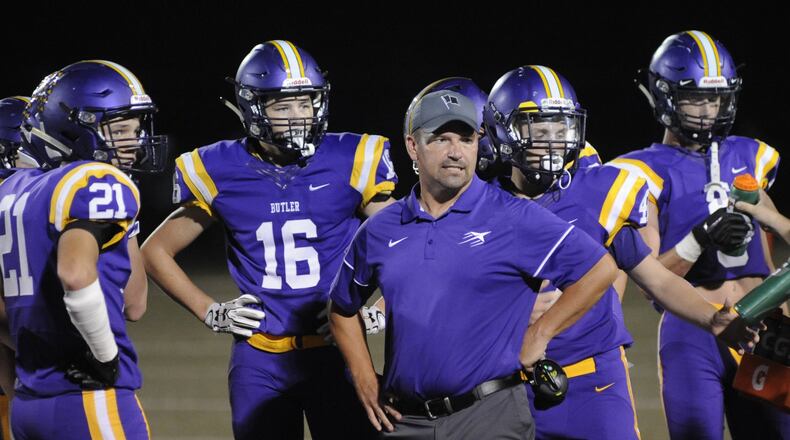“We want as coaches just to be a part of the solution, and I think this is a great step,” said the coach at Butler. “The committee that put this together I think did a phenomenal job, and I fully support it.
“I’ve communicated with my region of Montgomery, Warren and Butler County that this is a working document so it’s not like this is set in stone, but this is kind of like where we want to start.”
The key elements are distance and time.
“Maintain social distancing” has become a common refrain in all walks of life since the novel coronavirus began spreading locally in late winter and causing COVID-19.
The OHSFCA proposal devotes plenty of space to that concept as a result.
It includes methods for expanding room on the sidelines and in the stands, reducing time in locker rooms and staying apart during timeouts, before and after games.
On buses, wearing masks will be required and sharing seats forbidden.
The proposal includes pictures of meetings and familiar drills being staged with more distance than a year ago, too, but that does not address the central aspect of football.
What about the average play?
How can social distancing be maintained in a sport where 22 people share a field at one time and at least half of them spend most or all of every play pushing up against each other?
That is where time comes in.
The proposal suggests limiting practice groups to nine players or less and conducting periods for no more than nine minutes at a time.
It also relies on Centers for Disease Control determination that individuals who spend less than 15 minutes in “constant close contact” are not at increased risk of community spread of the virus.
While practices and games last far longer the 15 minutes, the OHSFCA committee used the average length of a play (4-6 seconds) and the average number of plays in a game to conclude even offensive and defensive linemen who are engaged in full contact for the entire play spent less than 15 minutes in close contact over the course of an average game over the past three years.
Time in close contact is important not just to prevent the spread of the disease but to satisfy CDC guidelines for quarantining the contacts of individuals who test positive for COVID-19 without being forced to send some or even all of a team into self-isolation for a week or more.
“That was our interpretation,” said Tom Pavlansky, the coach at Cortland Lakeview in Trumbull County. “The phrase is ’15 minutes of continuous contact,' so like if you and I are sitting in a room for longer than 15 minutes within six feet of each other, the chances for infection are high. If you’re there less than 15 minutes, then the chances are lower if you’re within the six feet distance.”
In addition to laying out methods for maintaining social distancing and mitigating the spread of COVID-19, the coaches’ document also cites a study from the University of Wisconsin that found a rise in the prevalence of depression symptoms in adolescent athletes related to school closures and cancelations in that state.
“Obviously the pandemic’s been a very stressful time,” Pavlansky said. “Anxiety, depression, isolation, all those things factor in, especially in our young people. And having sports, having football, I think that’s going to help them. And I hope people understand this has been a hard time on our young people, and we can’t take them for granted. We’ve got to make sure that we address those issues. And I think one of those ways we address those is getting kids back in a routine, get kids back in a structured situation, getting kids outside in the athletic arena. All those things are healthy for the kids.”
About the Author

